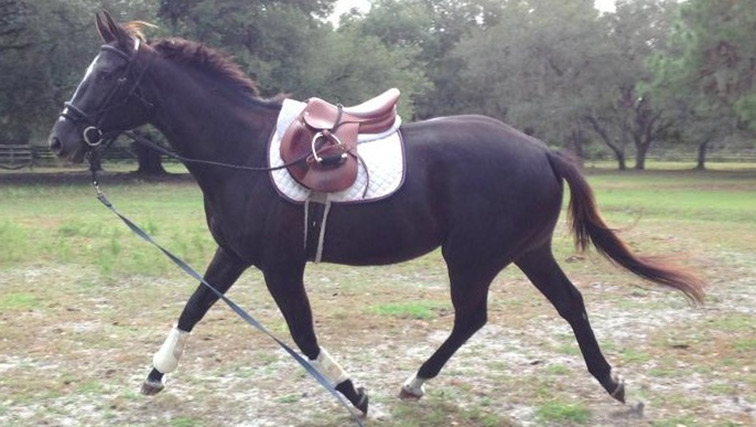Program Spotlight: Thoroughbred Retirement of Tampa

Prayers at Mass, who was retired in early 2013, gets lunged before her training session at TROT's facility (Photo courtesy of TROT).
Started in 2003 as Thunder Bay Horse Rescue, Thoroughbred Retirement of Tampa, Inc. (TROT) is now the official Thoroughbred retirement and aftercare program for Tampa Bay Downs.
Since a change of ownership and name in 2009, 37 horses have found new homes through TROT with 15 horses currently in the program. At the moment, TROT is limited to only taking horses who are racing at the live meet at Tampa Bay Downs, but the program hopes to be able to accept any horse who raced at Tampa Bay Downs after they get increased funding in the future.
Horses are given a month of downtime when they come to TROT, with some horses finding new homes before they ever enter the retraining phase of the program. Once the recently retired racehorse has had time to “be a horse,” the program focuses on basic retraining instead of focusing on a specific discipline. Horses are put up for adoption quickly after arriving at the facility, giving potential adopters a variety of training projects.
Run completely by volunteers, it takes between one to two weeks for a potential adopter to be approved by TROT with the program requiring both references and a site check during the approval process. Once someone is approved to adopt a horse, they must sign an adoption agreement and a bill of sale.
“The adoption agreement and lifetime conditional bill of sale, which is available on our website, includes a 60-day trial period, a one-year probationary period and two-year right of first refusal,” said Christine Tutcher, TROT’s secretary and treasurer. “The horse cannot race or be sold at auction. We are also adding a no slaughter clause to the contract. Written updates with photos are required from the adopter during the probationary period and we may perform random inspections during that time. We also indicate minimum requirements for the care of the adopted horse.”
LIFE AT TROT
Photos courtesy of TROT
When considering a Thoroughbred straight from the track, Tutcher recommends that someone experienced with off-the-track Thoroughbreds help with the horse search. It is also recommended that the buyer knows what he or she is looking for in a horse and that the Thoroughbred is purchased from a reputable trainer or owner. As for what to do with the horse once it is home, Tutcher has some simple advice.
“Treat them like a horse. They are just a horse … that has more knowledge and life experience than the average horse,” she said. “They know racing and will need time to adjust to another lifestyle. Give them the time they need mentally and physically to be prepared to start retraining. Think of it like a person moving to another country, another life, and another language. Some will need more time than others to adjust; they are all individuals. Give them that time. Turn them out in a pasture; reintroduce them to living in a herd; be confident, yet kind.”
TROT has seen the popularity of Thoroughbreds increase over the past few years and the program believes it has happened for a number of reasons.
“Perhaps it's due to the downward slide of the economy and the fact that OTTBs are available for a relatively inexpensive price, especially directly off the track and from Thoroughbred placement organizations,” Tutcher said. “Also, as the fad of riding a giant-sized warmblood decreases, the English show world sees the value in a smaller, lighter-framed horse simply easier to maintain over time.”
For those looking to help TROT, the program is a 501(c)(3) organization that is open to donations. Fans can donate through PayPal, the program’s Facebook page, or by sending a check to the program. The program also has a wish list of items the horses need on its website for those who would like to donate items instead of money.
As a volunteer-run program, TROT is always looking for volunteers with horse experience to assist with caring for the horses. Those without horse experience can assist in a variety of other ways, including helping with chores around the barn, pre-adoption site inspection and adopter follow-up visits.
Tutcher recommends that anyone looking to adopt a horse off the track read “Beyond the Track: Retraining a Thoroughbred from Racehorse to Riding Horse” by Anna Ford. The book gives insight on life at the track and how to help retired racehorses adjust to their new careers. For those looking for another reason to consider Thoroughbred adoption, Tutcher has one final piece of advice.
“They will do anything for you; you just need to give them a chance. Enjoy the Thoroughbred horse for all it is.”
For more information on Thoroughbred Retirement of Tampa, Inc. you can visit its website at http://tampatrot.org.
If you know of a Thoroughbred Aftercare program that you think should be covered in America’s Best Racing’s Aftercare Program Spotlight, email Melissa Bauer-Herzog (mbauer-herzog@jockeyclub.com) with the program’s name and website.
